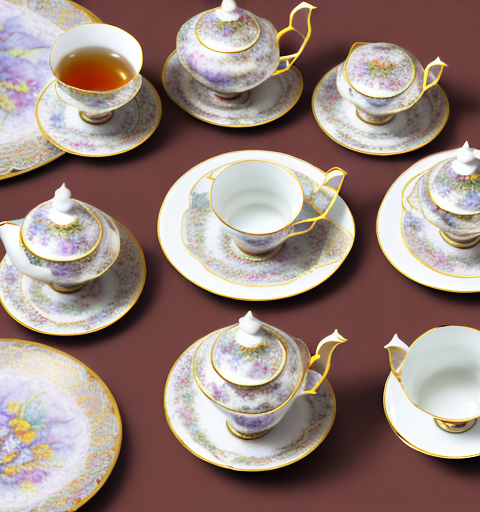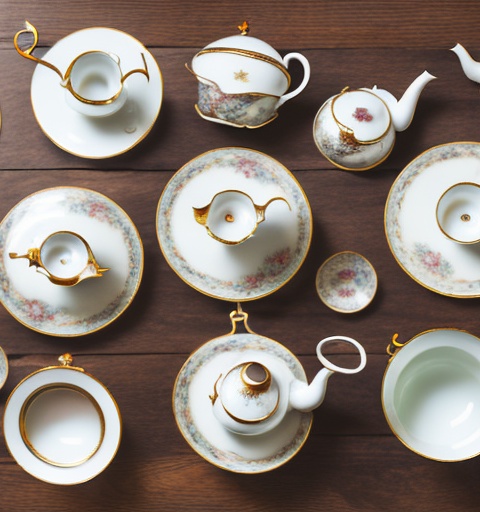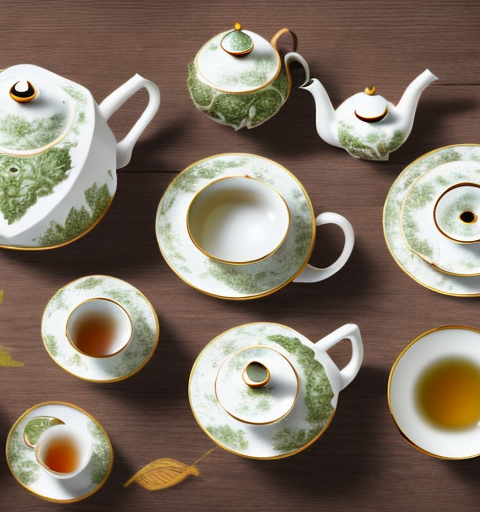Maintaining a clean and stain-free teapot handle is essential for both the aesthetic appeal and functionality of your beloved teapot. Over time, the ceramic handle of your teapot can become discolored and tarnished with tea stains, especially if it has a beautiful decorative motif. In this article, we will explore the importance of keeping your teapot handle clean, identify the materials used in ceramic handles, and provide a step-by-step guide to removing tea stains effectively.
Understanding the importance of maintaining a clean teapot handle
A clean teapot handle not only enhances the overall appearance of your teapot but also ensures hygienic tea preparation. Tea stains not only look unsightly but can also harbor bacteria, affecting the taste and aroma of your favorite brew. By regularly cleaning your teapot handle, you can enjoy a more pleasant tea-drinking experience, free from stains and potential health risks.
In addition to the aesthetic and hygienic benefits, maintaining a clean teapot handle can also prolong the lifespan of your teapot. Tea stains and residue can gradually build up on the handle, causing it to become sticky or even corroded over time. By regularly cleaning the handle, you can prevent this buildup and ensure that your teapot remains in good condition for longer.
Furthermore, a clean teapot handle can also contribute to better heat insulation. When the handle is covered in stains or residue, it can affect the heat distribution and make it uncomfortable to hold the teapot. By keeping the handle clean, you can ensure a more comfortable and enjoyable tea-drinking experience, as the handle will stay cool to the touch even when the tea inside is hot.
Identifying the materials used in the ceramic handle of your teapot
Ceramic teapot handles can vary in terms of the materials used. Some handles may be glazed, while others may have a matte finish. It is crucial to identify the specific type of ceramic handle you have before proceeding with any cleaning methods. Glazed handles are generally more resistant to stains, while matte handles may require more gentle cleaning techniques to avoid damage.
Another type of ceramic handle commonly used in teapots is a hand-painted handle. These handles are often decorated with intricate designs or patterns, adding a touch of artistry to the teapot. When cleaning a hand-painted ceramic handle, it is important to use mild cleaning agents and avoid scrubbing too vigorously to prevent any damage to the delicate artwork.
In addition to glazed, matte, and hand-painted handles, some teapots may also feature handles made from a different material altogether, such as wood or metal. These handles can provide a unique aesthetic and may require specific cleaning methods. For wooden handles, it is important to avoid soaking them in water for extended periods to prevent warping or cracking. Metal handles may require polishing to maintain their shine and prevent tarnishing over time.
Step-by-step guide to removing tea stains from a ceramic teapot handle
Removing tea stains from a ceramic teapot handle can be achieved with a few simple steps. Follow the guide below:
- Prepare a cleaning solution by mixing warm water with a gentle dish soap.
- Dampen a soft cloth or sponge in the cleaning solution and gently scrub the stained areas of the teapot handle.
- Rinse the handle thoroughly with warm water to remove any soap residue.
- If the stains persist, create a paste by mixing baking soda with water and apply it to the affected areas.
- Gently scrub the stained areas using a soft cloth or sponge.
- Rinse the handle once again to remove any residue.
- Dry the teapot handle thoroughly with a clean cloth.
By following these steps, you can effectively remove tea stains from your ceramic teapot handle, restoring its original beauty.
Tea stains can be stubborn and may require additional steps for complete removal. If the above method does not fully remove the stains, you can try using white vinegar as an alternative cleaning solution. Mix equal parts of white vinegar and water, and follow the same steps mentioned earlier.
For tougher stains, you can also try using a paste made from lemon juice and salt. Apply the paste to the stained areas and let it sit for a few minutes before scrubbing gently. Rinse thoroughly and dry the handle as usual.
The importance of using gentle cleaning methods for delicate ceramic handles
Ceramic handles with decorative motifs are often delicate and require cautious cleaning to avoid any damage. While it may be tempting to use harsh cleaning agents or abrasive materials, it is important to refrain from doing so, as it can cause irreversible harm. Instead, opt for gentle cleaning methods such as the ones outlined in the step-by-step guide above. Remember, patience and a gentle touch are key when dealing with delicate ceramic handles.
Using gentle cleaning methods not only helps preserve the delicate ceramic handles but also ensures their longevity. Harsh cleaning agents and abrasive materials can not only cause immediate damage but also weaken the structure of the handles over time. By using gentle cleaning methods, you can maintain the beauty and functionality of the handles for years to come. Additionally, it is important to regularly inspect the handles for any signs of wear or damage and address them promptly to prevent further deterioration. Taking these precautions will help you enjoy your delicate ceramic handles for a long time.
Exploring different household items that can effectively remove tea stains
If you prefer to use natural or readily available household items for stain removal, several options can effectively help eliminate tea stains from your ceramic teapot handle. These include:
- White vinegar: Diluted white vinegar is known for its stain-removing properties. Apply a small amount to a cloth or sponge and gently scrub the stains.
- Lemon juice: The acidic nature of lemon juice can help break down tea stains. Apply lemon juice to a cloth or sponge and gently scrub the affected areas.
- Baking soda: A paste made from baking soda and water can be used as a gentle abrasive to remove stubborn tea stains. Apply the paste to the stains and scrub gently.
These household items can be effective alternatives to commercial cleaning products, offering natural and eco-friendly stain removal options.
In addition to these household items, there are a few other options you can try to remove tea stains from your ceramic teapot handle. One option is hydrogen peroxide, which can be applied directly to the stains and left to sit for a few minutes before scrubbing. Another option is toothpaste, which contains mild abrasives that can help lift tea stains. Apply a small amount of toothpaste to a cloth or sponge and gently scrub the affected areas. Remember to rinse the teapot handle thoroughly after using any of these methods to remove any residue.
Tips for preventing tea stains on your ceramic teapot handle
Prevention is always better than cure. To minimize tea stains on your teapot handle, consider implementing the following tips:
- Regular cleaning: Clean your teapot handle after each use to prevent stains from building up.
- Immediate rinsing: Rinse the handle with warm water immediately after pouring tea to minimize the exposure of tannins to the ceramic surface.
- Avoiding direct contact: If possible, hold your teapot by the body rather than the handle to prevent direct contact with tea.
- Using a cozy or sleeve: Utilize a teapot cozy or sleeve to protect the handle from tea spills and stains.
By incorporating these preventive measures into your tea routine, you can significantly reduce the occurrence of tea stains on your ceramic teapot handle.
Additionally, it is important to note that the type of tea you use can also affect the likelihood of stains on your ceramic teapot handle. Certain teas, such as black tea and herbal teas, are more likely to leave stains compared to lighter teas like green or white tea. If you frequently brew darker teas, you may want to consider using a separate teapot or handle specifically for those teas to minimize staining on your ceramic teapot handle.
How to preserve the decorative motif on your teapot handle while removing stains
Preserving the decorative motif on your teapot handle is crucial while removing tea stains. Here are some tips to avoid damaging the motif:
- Use soft materials: When cleaning, opt for soft cloths or sponges to minimize the risk of scratching or fading the decorative motif.
- Avoid abrasive substances: Harsh chemicals or abrasive substances should be strictly avoided, as they can erode or discolor the motif.
- Gently scrub: Employ gentle scrubbing motions, applying even pressure, to ensure effective stain removal without causing harm to the handle’s decorative elements.
By taking these precautions, you can successfully remove tea stains while preserving the visual appeal of your teapot handle’s decorative motif.
Additionally, it is important to note that excessive exposure to water can also damage the decorative motif on your teapot handle. To prevent this, make sure to dry the handle thoroughly after cleaning. Use a soft, absorbent cloth to remove any moisture and avoid leaving the handle wet for extended periods of time. This will help maintain the integrity of the motif and prevent any potential water damage.
Exploring alternative cleaning methods for stubborn tea stains
If you encounter particularly stubborn tea stains on your ceramic teapot handle, you may need to explore alternative cleaning methods. Here are a few additional techniques to consider:
- Toothpaste: Non-gel toothpaste can be applied to the stains and gently scrubbed using a soft cloth.
- Denture cleaning tablets: Dissolve a denture cleaning tablet in warm water and soak the teapot handle for a few hours. Rinse thoroughly afterward.
- Hydrogen peroxide: Diluted hydrogen peroxide can be used as a gentle bleach alternative for stubborn tea stains. Apply with caution and rinse thoroughly.
Remember to test any alternative cleaning method on a small inconspicuous area of the handle first to ensure it does not cause any damage.
Vinegar: White vinegar can be an effective cleaning agent for stubborn tea stains. Mix equal parts vinegar and water, then apply the solution to the stains and scrub gently with a cloth or sponge. Rinse thoroughly afterward.
Baking soda: Create a paste by mixing baking soda with water. Apply the paste to the tea stains and let it sit for a few minutes. Scrub gently with a soft cloth or sponge, then rinse thoroughly. Baking soda can help remove stains and odors.
The role of regular maintenance in preventing tea stains on ceramic handles
Regular maintenance is key to preventing tea stains on ceramic handles. By incorporating a few simple habits into your tea routine, you can significantly reduce the occurrence of stains. Here are some essential maintenance tips:
- Handwashing: Always handwash your teapot and handle rather than using a dishwasher, as harsh dishwasher detergents can cause fading or discoloration.
- Thorough drying: Ensure your teapot handle is completely dry before storing it to prevent moisture accumulation and potential staining.
- Storage precautions: Store your teapot handle in a clean, dry place away from direct sunlight or excessive humidity to avoid any unnecessary stain development.
By adopting these maintenance practices, you can enjoy a clean and stain-free teapot handle for years to come.
Additionally, it is important to regularly inspect your ceramic handles for any signs of wear or damage. Cracks or chips in the handle can create areas where tea stains can easily accumulate. If you notice any damage, it is recommended to replace the handle to maintain its functionality and prevent staining. Regularly checking and replacing damaged handles will help ensure the longevity and cleanliness of your teapot.
Understanding the potential damage that harsh cleaning agents can cause to ceramic handles
While it may be tempting to resort to harsh cleaning agents for quick stain removal, it is essential to understand the potential damage they can cause to ceramic handles. Cleaning agents containing harsh chemicals or abrasive particles can erode the ceramic surface, strip away glazes, or fade the decorative motif. Avoid using such cleaning agents to preserve the longevity and beauty of your teapot handle.
Exploring natural remedies for removing tea stains from ceramic teapot handles
Natural remedies can be a safe and effective alternative for removing tea stains from ceramic teapot handles. Here are a few natural remedies to consider:
- Vinegar and baking soda paste: Create a paste by combining vinegar and baking soda. Apply the paste to the stained areas and gently scrub with a soft cloth or sponge.
- Citric acid: Dissolve citric acid in warm water and soak the handle for a few hours. Rinse thoroughly afterward.
- Salt and lemon juice: Create a mixture of salt and lemon juice and rub it onto the stained areas. Rinse off afterward.
These natural remedies can be effective in removing tea stains while being gentle on your ceramic teapot handle.
How to restore the shine and luster of your ceramic teapot handle after stain removal
After successfully removing tea stains from your ceramic teapot handle, you may notice a slight dulled appearance. To restore its shine and luster, you can follow these simple steps:
- Prepare a cleaning solution by mixing warm water with a few drops of mild dish soap.
- Dip a clean, soft cloth into the solution and gently wipe the handle, removing any residue.
- Rinse the handle with warm water to remove any soap remnants.
- Using a dry, clean cloth, buff the handle to restore its shine.
By following these steps, your ceramic teapot handle will regain its original beauty, leaving no trace of the previous tea stains.
Tips for maintaining a clean and stain-free teapot handle on a regular basis
To maintain a clean and stain-free teapot handle on a regular basis, consider implementing the following tips:
- Regular cleaning routine: Establish a routine of cleaning your teapot handle after each use, using the appropriate cleaning methods.
- Inspect for stains: Regularly inspect your teapot handle for any signs of stains, allowing you to address them promptly.
- Avoid excessive tea spillage: Be mindful while pouring tea to minimize spills, which can lead to stains on the handle.
- Wipe off any spills: If any tea spills onto the handle, wipe it off immediately with a clean, damp cloth.
By incorporating these habits into your tea ritual, you can maintain a clean and stain-free teapot handle effortlessly.
The benefits of using specialized cleaning products for ceramic teapot handles with decorative motifs
Specialized cleaning products designed specifically for ceramic teapot handles with decorative motifs offer several benefits. These products are formulated to effectively remove stains without causing harm to the delicate ornamentation. Additionally, they are often pH-balanced and gentle, ensuring the longevity of both the handle and the decorative motif. When choosing a specialized cleaning product, always opt for one that is recommended for your specific type of ceramic handle and decorative motif.
In conclusion, removing tea stains from the ceramic handle of a teapot with a decorative motif requires careful attention to detail. By following the step-by-step guide and incorporating the tips and precautions provided, you can ensure effective stain removal while preserving the visual appeal and integrity of your teapot handle. Regular cleaning, gentle techniques, and preventive measures are essential in maintaining a clean and stain-free handle for enjoying countless delightful tea moments.






